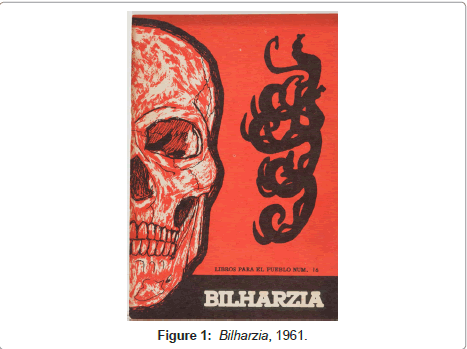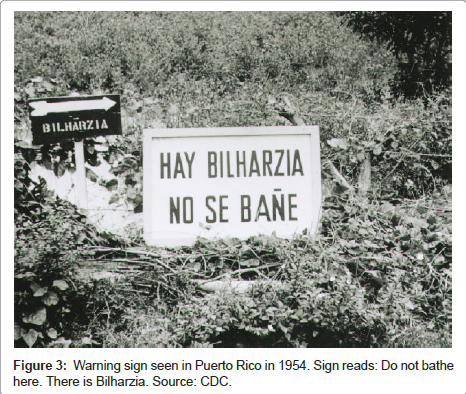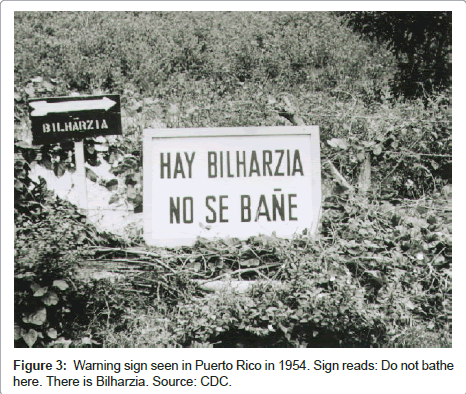Research Article Open Access
Schistosomiasis Control in Puerto Rico-The Division of Community Education
Cristóbal S Berry-Cabán*
College of Pharmacy & Health Sciences, Campbell University, North Carolina, USA
- *Corresponding Author:
- Cristóbal S Berry-Cabán
College of Pharmacy & Health Sciences
Campbell University, Buies Creek
North Carolina, USA
Tel: 910-907-8844, 813-451-3004
E-mail: cristobal.s.berry-caban.civ@mail.mil, cbcaban@gmail.com
Received date: September 04, 2013; Accepted date: November 26, 2013; Published date: November 28, 2013
Citation: Berry-Cabán CS (2013) Schistosomiasis Control in Puerto Rico-The Division of Community Education. J Community Med Health Educ 3:251. doi: 10.4172/2161-0711.1000251
Copyright: © 2013 Berry-Cabán CS. This is an open-access article distributed under the terms of the Creative Commons Attribution License, which permits unrestricted use, distribution, and reproduction in any medium, provided the original author and source are credited.
Visit for more related articles at Journal of Community Medicine & Health Education
Abstract
In the early 1950’s Puerto Rico began a 14 year program to eliminate schistosomiasis from the island. The Division of Community Education (DIVEDCO) was created to bring together rising authors, artists, composers, and filmmakers on the island to produce a series of materials– pamphlets, films, and posters– that educated the people about issues such as health, public safety, democracy, literacy, and civic participation. One such pamphlet published was Bilharzia that in 24 brief pages outlines the history, occurrence, reservoir, susceptibility, treatment, and control measures of schistosomiasis on the island.
Keywords
Susceptibility; Schistosomiasis; Ccercariae
Introduction
Schistosomiasis mansoni, known colloquially as bilharzia, came to Puerto Rico with the slave trade [1-3]. At the beginning of the 20th century, schistosomiasis was limited to several low-prevalence locations in Puerto Rico (Mayaguez, Utuado and Aibonito) and the adjacent island of Vieques an area of high prevalence. The change from a coffee economy (that was precipitated in part by Hurricane San Ciriaco in 1899) to sugarcane cultivation and the subsequent construction of large-scale irrigation systems, produced massive migrations of workers from the mountains to the coastal regions [4]. As sugar cultivation increased so did schistosomiasis.
Schistosomiasis is an infection with one of a series of related trematode parasites that are endemic to at least 78 tropical and subtropical countries. Over 200 million people have this disease; 120 million of them have symptoms, 20 million have severe illness and 600 million others remain at risk [5]. Four species routinely infect the human host. The majority of Schistosoma mansoni and Schistosoma haematobium infections are found in sub-Saharan Africa. Schistosoma mansoni remains endemic to parts of Brazil, Venezuela and the Caribbean. Schistosoma mekongi is found in Cambodia and Laos, along the Mekong River Delta. Schistosoma japonicum infection occurs in China, Indonesia and the Philippines [6].
The ecology of schistosomiasis includes tropical lotic (lakes and reservoirs) and lentic environments (rivers). Controlling schistosomiasis is especially daunting, primarily because the parasites are thoroughly integrated into the ecosystems in which they occur. A notable exception is Japan, where Schistosoma japonicum was eradicated from all of its islands by 1976, based largely on ecological approaches.
However, most underdeveloped countries do not have the political stability, infrastructure, or the financial resources to implement such massive control measures; additionally, civil unrest and warfare have also taken their toll. Thus, schistosomiasis will remain a health problem for some time to come. Despite major advances in control and substantial decreases in morbidity and mortality, schistosomiasis continues to spread to new geographic areas. Furthermore, there are reports of resistance to praziquantel, the mainstay of medical treatment [6,7].
Schistosomiasis has been extensively studied in Puerto Rico [1,8-13]. In 1906, fecal samples from 600 Puerto Ricans were examined without finding any schistosome eggs. Three years later over 2,600 persons had been examined without discovering any schistosome eggs in their feces. However, in 1914, a large scale irrigation system for sugar cane was constructed in the south. The prevalence of infection in children from Guayama, a town in the irrigated zone, rose from 0 to 25% soon after irrigation began [4]. Between 1904 and 1959 240,605 single fecal tests were conducted of which 10% were positive for schistosomiasis [14]. Likewise, in 1945 the US Army Medical Corps discovered that nearly 10% of 19,139 Selective Service recruits aged 18- 38 were infected [1].
Methods
This study describes the pamphlet Bilharzia published by the Division of Community Education as part of its series Books for the People. A brief overview of the division that developed and distributed it as well as its place in the social milieu in which the publication appeared are examined.
Findings
The division of community education
In 1948 Puerto Rican poet, journalist and politician Luis Muñoz Marín became the first elected governor. From the beginning of his administration that lasted until 1965 Muñoz Marín worked toward improving living conditions throughout the island, especially among the rural peasantry.
The Commonwealth of Puerto Rico, established in 1952, redefined the political relationship between the United States and the island. A new ambiguous political status-autonomy without sovereignty, self-government without self-determination- set-out to create a new social, political, and cultural identity. Muñoz Marín, was committed to promoting a Puerto Rican cultural identity centered around the idealization of traditional rural life, while simultaneously attempting to create a new democratic citizenry, both of which would bolster the new government’s legitimacy.
Among the governor’s first projects was the formation of the Division of Community Education (División de Educación de la Comunidad). DIVEDCO, as it was commonly known operated for over 40 years and its impact on the health of Puerto Ricans is well recognized [15]. DIVEDCO brought together rising authors, artists, composers, and filmmakers to produce pamphlets, films, and posters that educated the people about health, public safety, democracy, literacy, and civic participation issues [15,16].
Muñoz Marín’s idea of using literature, art, and film, was inspired by the Federal Art Project the visual arts arm of the Works Progress Administration, the largest of the New Deal agencies established by President Franklin D. Roosevelt. Three individuals who had been involved with Roosevelt’s New Deal also played key roles in the development of DIVEDCO: Edwin Rosskam served as its first director, and the husband and wife team of Jack and Irene Delano were in charge of the film and graphics departments [16-18].
Print materials played a predominant role in the promotion of health education at DIVEDCO and encompassed both pamphlets and posters. These tools provided health and community educators with much needed information on diseases and conveyed important preventive health messages motivating people to take actions to improve their health.
Over a period spanning nearly 40 years DIVEDCO produced and distributed, free of charge, some forty educational pamphlets on various subjects. Copiously illustrated by DIVEDCO’s leading artists, this series of pamphlets called Libros Para el Pueblo (Books for the People) were written in simple language, and contained stories, poems, essays, and other short texts with clear, direct messages that could be understood by audiences of all ages and educational levels. Most books contained a brief introduction that explained the nature and purpose of the readings, and pointed out the lessons that they aimed to teach. Some also included brief quizzes at the end that were meant to help readers synthesize the information contained in the book. Thousands of copies of each pamphlet were distributed throughout the island by DIVEDCO field workers, who also stressed the importance of the books and encouraging rural communities to discuss the texts among themselves and apply its principles.
Books for the people
Bilharzia. Bilharzia published in 1961 and reprinted in 1968 was edited by René Marqués; written by Benji Donniger and Fred Ward; and illustrated by Carlos Rivera, Antonio Maldonado, Isabel Bernal among others [19]. In 24 brief pages the writers outline the history, occurrence, reservoir, susceptibility and treatment and control measures of schistosomiasis. The cover is striking (Figure 1). It features a skull and is printed in bright red with a simple one-word title Bilharzia. This booklet’s dramatic cover illustration, by Carlos Osorio, embodied DIVEDCO’s belief in the power of art to communicate important messages to audiences that were largely made up of semiliterate peasant families.
All species of schistosomes use freshwater snails as intermediate hosts that are essential to the completion of their life cycle. The infection is generally acquired by agricultural work, domestic chores or recreational activities such as swimming or bathing in fresh water contaminated with the parasites.
The face page of Bilharzias shows the “Cycle of Death” (Figure 2). An infected man is pictured defecating in a river thus eliminating eggs with his feces or urine. Under optimal conditions the eggs hatch and release miracidia that swim and penetrate specific snail intermediate hosts (in this case Australorbis glabratus). The cercariæ leave the snail and penetrate skin and finally another person is infected. The stages in the snail include two generations of sporocysts and the production of cercariae. Upon release from the snail, the infective cercariae swim, penetrate the skin of the human host, and shed their forked tail, becoming schistosomulae. The schistosomulae migrate through several tissues and stages to their residence in the veins. Adult worms in humans reside in the mesenteric venules in various locations that at times seem to be specific for each species: for instance, Schistosoma japonicum is more frequently found in the superior mesenteric veins draining the small intestine, and Schistosoma mansoni occurs more often in the superior mesenteric veins draining the large intestine. However, both species can occupy either location, and they are capable of moving between sites, so it is not possible to state unequivocally that one species only occurs in one location. Schistosoma haematobium most often occurs in the venous plexus of bladder, but it can also be found in the rectal venules. When people with the disease urinate or defecate in fresh water, these eggs are passed and the cycle begins again.
Each stage of this cycle is further amplified in the pamphlet. It begins with “What is Bilharzia.” After a very brief history of schistosomiasis, it presents a fictitious account of an 8 year old boy, who while being examined at the Fajardo District Hospital is found infected with thousands of eggs. This leads the reader to a chapter on how one contracts schistosomiasis. Each chapter presents a small vignette, “It’s Monday. Mother and daughter have clothing to wash. The stream is fresh and there is place where one can wash and talk to the neighbors.”
Symptoms and treatment are described. When the adult flukes begin laying eggs (about 4 to 8 weeks later, vague discomfort (malaise), fatigue, fever, and abdominal pain, may develop. The pamphlet describes how in an advanced stage schistosomiasis may include: abdominal pain, enlarged liver, blood in the stool or blood in the urine, and problems passing urine and of course urticaria.
If schistosomiasis is ascertained early on the pamphlet suggests, there are more opportunities for treatment. Until recently (i.e., early 1960s), it states, tartar emetic, a poisonous crystalline compound was used as an expectorant for the treatment of schistosomiasis. In recommended the antimony compound Faudin, also known as Stibophen, an intramuscular injection. Anyone under treatment should have their stool examined regularly recognizing that it may take up to two years to become disease free.
“What is the Government Doing?” In this chapter the government’s efforts are examined. The lead agency being the Puerto Rican Department of Health. “Death to the Australorbis,” describes the government’s efforts to eliminate the snail from the island’s rivers. Other efforts included access to potable water and sanitary education is reviewed.
Lastly the book ends with a chapter on “What can you do,” that describes simple efforts such as boiling water, what to do if you don’t have a latrine and an exhortation to “read this book and other materials and discuss it with members of your community”.
Discussion
Bilharzia was part of a concerted program to control the disease. Launched in 1953, the program used limited chemotherapy and snail control by environmental, biological and chemical means. At the same time, extensive programs of water supply, health education and free latrine distribution were implemented across the island (Figure 3).
Schistosomiasis is one of the tropical diseases targeted for control by the Special Program for Research and Training in Tropical Diseases of the United Nations Development Program, the World Bank and the World Health Organization (WHO). As early as 1950 the WHO emphasized the dangers of developing irrigation schemes in regions infected with schistosomiasis [20]. The 65th World Health Assembly has set a goal of treating annually at least 75% of school-age children infected with schistosomes [8].
Puerto Rico has made great strides in ameliorating schistosomiasis. In a review article, George Hillyer shows the efforts taken since 1904 toward identifying, documenting and abating schistosomiasis [9]. By 1976 the proportion of children reacting positively to the skin test decreased from 24% in 1963 to 5%. During the 1980’s very few cases were reported [9] and in 1994 the Puerto Rico Department of Health established a commission to evaluate the status of schistosomiasis throughout the island. A 2012 schistosomiasis risk assessment noted that in Puerto Rico “low rates of infection have been reported from all parts of the island. Risk of infection is also present on the islands of Vieques and Culebra, both located off the eastern coast of Puerto Rico [20].”
Bilharzia was one of the many pamphlets produced by the DIVEDCO’s writers and artists. Created to educate as many people as possible, the pamphlets were striking and attractive, but they also captured the public’s attention. These pamphlets were often printed in editions of about 5,000 copies. Other health issues covered included The White Plague about tuberculosis, Science against Superstition, Blood and nutrition [15].
More than a government agency, DIVEDCO was a social experiment aimed at educating the masses. Many of the Libros Para el Pueblo was published as companion pieces for the DIVEDCO’s films, and in a similar manner, many of the films were inspired by the stories and essays in the booklets. Indeed, Bilharzia was released as a companion text to the 1960 film Sucedió en piedras blancas (It Happened in Piedras Blancas). Directed by Benji Doniger, it is the story of a young Puerto Rican government doctor who is assigned to fight schistosomiasis in a rural district and informs Puerto Ricans about the dangers posed by this common disease.
While there is no way to determine the impact of Bilharzia and other public health pamphlets in the series produced by DIVECO, in short, however, the carefully planned distribution of pamphlets, posters, and films among Puerto Rico’s rural peasantry was a key component of a 40-year public health and education campaign, through which the island’s government was able to foster not only community heath, development and self-reliance, but also a sense of national pride that was forever crystallized in the bountiful cultural production of the DIVEDCO.
References
- Farley J (1991) Bilharzia: a history of imperial tropical medicine. Cambridge history of medicine. Cambridge University Press 17: 757-954.
- Lammie PJ, Lindo JF, Secor WE, Vasquez J, Ault SK, et al. (2007) Eliminating lymphatic filariasis, onchocerciasis, and schistosomiasis from the americas: breaking a historical legacy of slavery. PLoS Negl Trop Dis 1: e71.
- Morgan JA, Dejong RJ, Snyder SD, Mkoji GM, Loker ES (2001) Schistosoma mansoni and Biomphalaria: past history and future trends. Parasitology 123 Suppl: S211-228.
- Jobin WR (1978) Tropical disease bilharzia and irrigation systems in Puerto Rico. Journal of the Irrigation and Drainage Division 104: 307-322.
- Chitsulo L, Engels D, Montresor A, Savioli L (2000) The global status of schistosomiasis and its control. Acta Trop 77: 41-51.
- Patz JA, Graczyk TK, Geller N, Vittor AY (2000) Effects of environmental change on emerging parasitic diseases. Int J Parasitol 30: 1395-1405.
- World Health Organization (2013). Schistosomiasis.
- Sixty-Fifth World Health Assembly (2012) Elimination of schistosomiasis. World Health Assembly 1-2.
- Hillyer GV (2005) The rise and fall of Bilharzia in Puerto Rico: its centennial 1904-2004. P R Health Sci J 24: 225-235.
- Meléndez PA, Capriles VA (2002) Molluscicidal activity of plants from Puerto Rico. Ann Trop Med Parasitol 96: 209-218.
- Torres EA, Acosta H, Cruz M, Weinstock J, Hillyer GV (2001) Seroprevalence of Schistosoma mansoni in Puerto Ricans with inflammatory bowel disease. P R Health Sci J 20: 211-214.
- Giboda M, Malek EA, Correa R (1997) Human schistosomiasis in Puerto Rico: reduced prevalence rate and absence of Biomphalaria glabrata. Am J Trop Med Hyg 57: 564-568.
- Rigau-Pérez JG, Pereira Díaz LA (1996) Hay Bilharzia!, by Klock, Ildefonso, and Mateo-Serrano: medical images of poverty and development in Puerto Rico in the 1950s. P R Health Sci J 15: 33-44.
- Ferguson FF (1965) Occurrence of Schistosoma Mansoni in Puerto Ricans. Public Health Rep 80: 339-344.
- Colon-Pizarro M (2011) Poetic Pragmatism: The Puerto Rican Division of Community Education (DIVEDCO) and the Politics of Cultural Production, 1949-1968.Romance Languages and Lteratures2011: 266.
- Thompson D (2005) Film music and community development in rural Puerto Rico: The DIVEDCO program (1948-91). Latin American Music Review 26: 102-114.
- Maira SM (2003) Cultural Negotiations: Puerto Rican Intellectuals in a State-Sponsored Community Education Project, 1948-1968. Harvard Educational Review 73: 416-448.
- Lloyd D (1997) The Institute of Puerto Rican Culture and the Building Blocks of Nationality. Sponsored Identities: Cultural Politics in Puerto Rico p 60.
- Donniger B, Wale F, Bilharzia., San Juan (1950) División de Educación de la Comunidad. The Third World Health Assembly, Bilharziasis World Health Assembly 16: 1961.
- International Association for Medical Assistance to Travellers.
Relevant Topics
- Addiction
- Adolescence
- Children Care
- Communicable Diseases
- Community Occupational Medicine
- Disorders and Treatments
- Education
- Infections
- Mental Health Education
- Mortality Rate
- Nutrition Education
- Occupational Therapy Education
- Population Health
- Prevalence
- Sexual Violence
- Social & Preventive Medicine
- Women's Healthcare
Recommended Journals
Article Tools
Article Usage
- Total views: 18456
- [From(publication date):
December-2013 - Dec 05, 2025] - Breakdown by view type
- HTML page views : 13637
- PDF downloads : 4819



